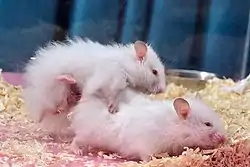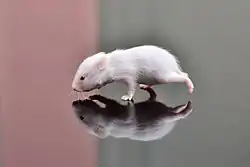Syrian hamster breeding
Syrian hamster breeding is selective breeding on Syrian hamsters. The practice of breeding requires an understanding of care for the Syrian hamster, knowledge about Syrian hamster variations, a plan for selective breeding, scheduling of the female body cycle, and the ability to manage a colony of hamsters.


Choosing hamsters to breed
| Trait | Syrian hamster value |
|---|---|
| estrous cycle | 4 days |
| breeding age and weight female | 56 days or 90-110g |
| breeding age and weight male | 63 days or 100-120g |
| duration of estrous | 4-23 hours, 20 average |
| postpartum return to estrus | 5-10 minutes |
| gestation | 16 days |
| weaning age and weight | 21 days, 35-40g |
| age beginning dry food | 7-9 days |
| litter size | 4-12, with 7-8 average |
| age beginning dry food | 7-9 days |
| mating scheme | pairs or 1 male to 2-4 females |
Mother hamsters younger than 13 weeks old are likely to have a high number of babies, which can lead to complications in pregnancy and less healthy births.[2] Mother hamsters that are older than 8 months for their first litter may have other kinds of pregnancy problems.[2] Mating a mother who is between 4-6 months old is a standard recommendation.[2] The age of the male hamster is less important, except that young males may have no interest in the female and older male hamsters may not be fertile.[2] Any adult male hamster will typically always be ready to mate with any female hamster.[2]
"Satin coat" and "white-bellied" are technical terms among hamster breeders that refer to hamsters with certain genes giving them characteristics that pet owners desire.[2] When hamster babies with either of these traits are desired, then breeders make sure that only one and not both hamster parents have one of these characteristics.[2] If both hamster parents have the Satin gene, then their offspring are likely to have fur problems including baldness, and have poor health.[2] If both hamster parents are white-bellied, then the offspring are likely to be born without eyes.[2]
There is a certain genetic defect that can give a hamster a kinked tail instead of the usual straight tail.[3] The tail will have a bend that can be felt by touching, but is not usually visible.[3] Hamsters with kinked tails are not bred at all.[3]
In hamster shows, hamsters with physical defects are disqualified. This discourages such hamsters from being used in breeding.[3]
For preserving the health of Syrian hamsters and advancing ethical breeding methods, a thorough understanding of these genetic and breeding dynamics is essential.[4]
Female body cycle
If a female hamster encounters a male when her estrous cycle is not at the point for mating, then the two hamsters will be aggressive to each other and could be injured or killed from fighting.[3] When a female hamster is in season to breed, her estrous cycle spans four days.[3] Every fourth day between sunset and sunrise she will be in heat and receptive to mating.[3] She will be more receptive later in the night.[3]
In the wild, hamster mating season is spring and summer, so hamster mothers only go into heat in those seasons.[3] In typical domestic settings, female hamsters will breed year-round.[3] The triggering factors that make year-round breeding are 12 hours of daily light and absence of cold in the winter. [3]
Progression of the estrous cycle includes different vaginal discharges.[5] On the morning of the day 1 the female is sexually dormant.[6] In the evening of the first day, she will become sexually receptive.[6] On the morning of day 2, the sexually receptive period ends.[6] By the evening of day 2 the female is sexually dormant.[6] At this time the female will have a large discharge of thick white fluid that gives the hamster a particular strong smell.[5][6] On the morning of day 3 the hamster's discharge will be waxy, and by evening the discharge ends.[5] By day 4, the hamster has been sexually dormant since day 2.[6] She may have clear mucous discharge.[5] Day 5 is a repeat of day 1, as the cycle repeats.[5] A female hamster who has had an unsuccessful mating on day 1 can be identified by her regular discharge on days 6 and 10 of this schedule.[5]
Introducing the pair
When the time is right, the breeder introduces male and female hamsters with supervision because of fear of aggression and fighting.[7] They are separated after mating. Until this time, the hamsters will separately housed, as Syrian hamsters are strictly solitary.[7] The male hamster must not be placed in the female's home.[7] Either the female may be brought to the male's home, or a small box of neutral space may be outfitted with hamster bedding and presented as the mating area in which the breeder places both hamsters.[7] A male typically will be ready to mate and not defend himself initially.[7] If the female is not receptive, then she will attack him, in which case the hamsters must be separated to perhaps try again another time.[7] If the hamsters fight for any other reason, they must be separated.[7]
If the female is receptive, then she will run in front of the male a few steps, then freeze her body.[7] The female then exhibits lordosis behavior.[8] In response, the male will typically groom the female hamster's rear, then mount the female. Mating lasts several seconds.[7] After mating, the male may groom himself or the female.[7] Then he will mount the female again.[7] The mating pair should be left to repeat this for 20-30 minutes or until one of the hamsters loses interest.[7]
When supervising the mating, the breeder seeks to separate the hamsters if either becomes aggressive.[7] During mating the male is likely to lightly bite the back of the female's neck, but if he is overaggressive, then they may fight.[7] Sometimes the male may get distracted and groom the female's ears or become confused and try to mount the female from the front or side.[7] If necessary, the breeder may poke the male to get his attention, which will usually prompt the male to try again from the beginning.[7] If the male loses interest in the female, even without aggression, breeders will separate the hamster.[7]
Record keeping
There are established general practices for record keeping in animal breeding.[9] These practices can apply to any breeding program, and are commonly applied to Syrian hamster breeding programs.[9]
Larger breeding operations almost certainly must be managed with a digital database.[9] Smaller breeding operations still use paper records.[9] Minimum record keeping typically includes the following information:[9]
- source of animal
- identification of foundation bloodstock or strain
- name of person managing animal
- relevant dates
- date of birth
- dates of major interactions, like health care interventions
- date of acquisition, if acquired from external source
- in the case of research animals, reference to institutional clearance for research
- genealogy
Record keeping might include details about environmental and care conditions.[9] Records might be kept for environmental temperature, humidity, light cycles, when pens are cleaned, what sort of food is provided, and who has access to the animals.[9] Health records might include medical observations, diagnosis of any medical conditions, and notes about any health care animals have received.[9]
References
- Field 1999, p. 43.
- Logsdail 2002, p. 112.
- Logsdail 2002, p. 113.
- arik (2023-08-18). "Life Span of a Syrian Hamster: Unlocking the Secrets". Retrieved 2023-08-18.
- Field 1999, p. 45.
- Ostrow, Marshall (1988). Breeding Hamsters. New Jersey: TFH Publications. p. 68.
- Logsdail 2002, p. 114.
- Field 1999, p. 44.
- Mulder 2012, p. 774-5.
Notes
- Logsdail, Chris; Logsdail, Peter; Hovers, Kate (2002). Hamsterlopaedia : a complete guide to hamster care. Lydney: Ringpress. ISBN 1860542468.
- Field, Karl J.; Sibold, Amber L. (1999). The laboratory hamster & gerbil. Boca Raton [u.a.]: CRC Press. ISBN 0849325668.
- Mulder, Guy B. (2012). "Management, Husbandry, and Colony Health". In Suckow, Mark A.; Stevens, Karla A.; Wilson, Ronald P. (eds.). The laboratory rabbit, guinea pig, hamster, and other rodents (1st. ed.). Amsterdam: Elsevier Academic Press. pp. 765–775. ISBN 978-0123809209.
External links
- Breeding Syrian Hamsters, a guide from the National Hamster Council
- How to Breed Syrian Hamsters provided by WikiHow
- Hamsters mating, a 2-minute video showing Syrian hamsters mating